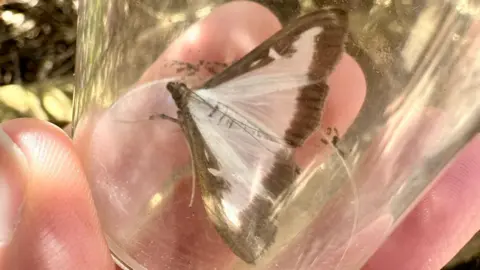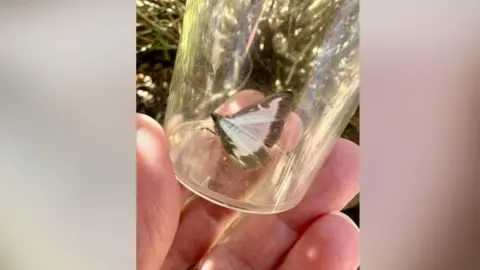Number of rare moths on the rise, experts say
 Washington Wetland Centre
Washington Wetland CentreA moth whose caterpillars can destroy the leaves of box plants is likely to become more common in north-east England, experts have said.
Originally an Asian species, the box tree moth arrived in England in 2007 and has since found a foothold in south-east England.
It was first recorded in the North East in 2017 and Dr Dave Wainwright, from the Butterfly Conservation charity, said numbers were increasing.
The moths had crossed the River Tees in the last couple of years and were "pushing northwards," Dr Wainwright said.
The box caterpillar has yellow and black stripes along its body, with a black head.
It has been causing problems for gardeners in the South East, with the Royal Horticultural Society (RHS) issuing a warning earlier this year.
Dr Stephanie Bird, plant health scientist at the RHS, said the main bulk of the insect's population was in London and the surrounding areas, but it was spreading and would become "more common in more northerly places" where box was being grown.
'A matter of time'
According to figures from Butterfly Conservation, there were 37 sightings of the moth in County Durham and north of the Tees from January to September this year alone - up from 27 for the whole of 2023.
Dr Wainwright, who is head of conservation for England at the charity, said some of the records would have been of several moths on the same night.
"They've certainly increased in the last year or two," he said.
Over the years, sightings have also been reported in Newbiggin and Amble in Northumberland, Tynemouth in North Tyneside and Gosforth in Newcastle.
 Washington Wetland Centre
Washington Wetland CentreIn August, an adult box tree moth was found for the first time at Washington Wetland Centre, near Sunderland.
Dr Wainwright said it was "significant" for the region and "only a matter of time" before the moths spread further north.
"I think if we were to have this conversation in 10 years, everyone would be absolutely sick of the sight of them because the caterpillars would be feeding on the box trees in the gardens," he said.
Dr Bird said she was not surprised by the sighting, although the species was still less common further north.
She said plant trade was helping the spread and the moths were also "quite strong flyers".
'Leave them be'
By the end of September, the RHS had received more than 6,457 reports of box tree moths nationwide.
It is currently up to gardeners and councils to manage the potential problems caused by caterpillars. The RHS is also researching natural predators of the moth, which include some parasitic wasps and spiders.
Darren Evans, professor of ecology and conservation at Newcastle University, said the caterpillars were a "real problem" for gardeners and could completely strip plants when in large numbers.
He advises not to use pesticides and to remove the caterpillars by hand instead.
"We should expect to see not just this type of moth, but a whole range of other species here in the North East driven by climate change," Prof Evans said.
"We have either got to think carefully what alternative plants we can grow in our gardens, or just recognise that they are now an established part of our biodiversity and just leave them be."
Follow BBC North East on X, Facebook, Nextdoor and Instagram. Send your story ideas to [email protected].
